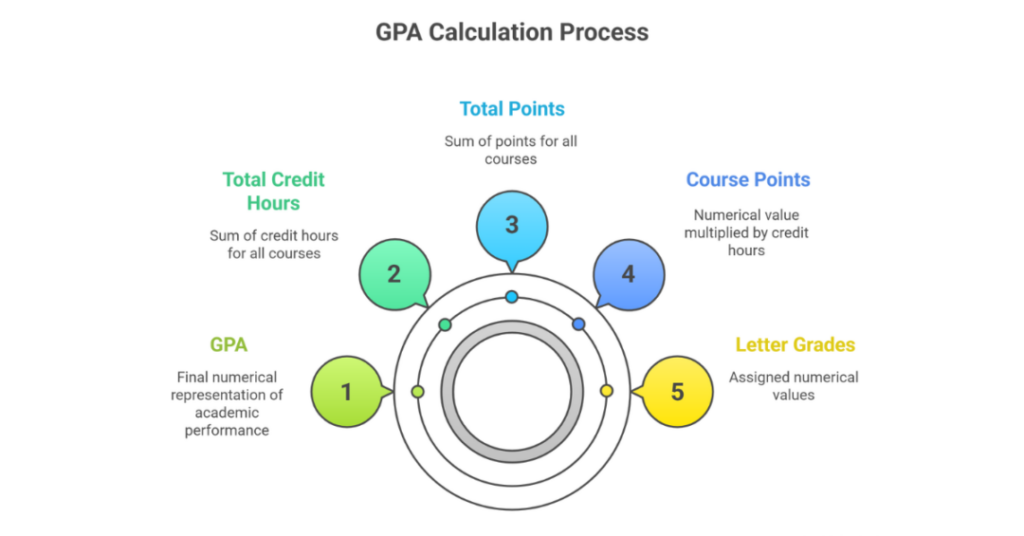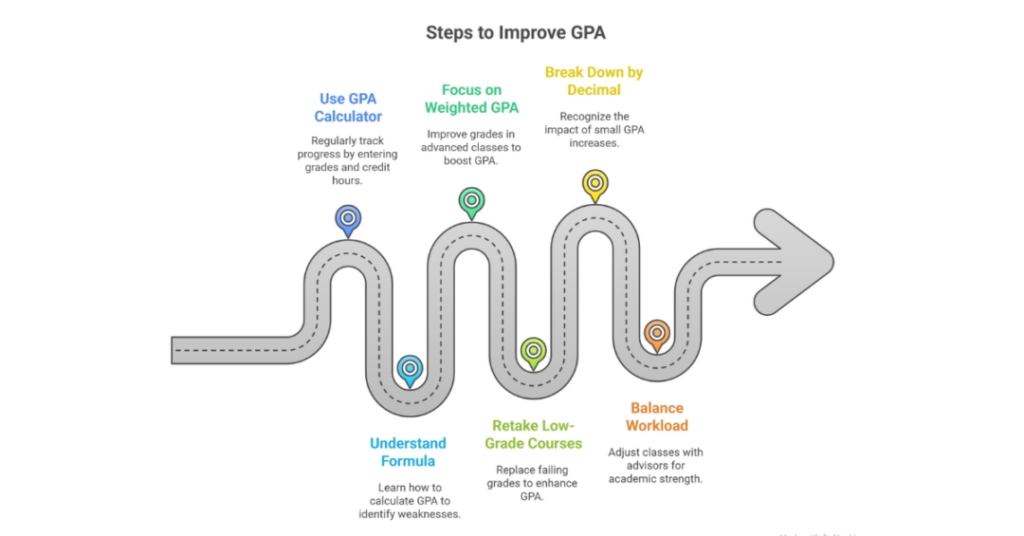29 July 2025
5 minutes read
How To Calculate Average GPA (Grade Point Average)

Key Takeaways
- How to calculate average GPA: Convert grades to points, multiply by credit hours, sum totals, and divide by total credits.
- Over 80% of U.S. colleges use GPA for admissions, scholarships, and job prospects, so knowing your score is essential.
- Improve your cumulative GPA by retaking low grades, tracking with a GPA calculator, and using weighted AP or honors classes.
Did you know that over 80% of colleges and universities in the United States use GPA as a key factor in admissions decisions? Calculating your grade point average accurately can make or break your academic future. Yet, many students struggle to understand the complex world of credit hours, letter grades, and grade points, often leaving them uncertain about their true academic standing.
Understanding how to calculate your GPA is a crucial skill that enables you to take control of your academic journey. By learning this simple yet powerful tool, you’ll gain valuable insights into your performance, identify areas for improvement, and set realistic goals for your educational pursuits.
What Is Average GPA?
Average GPA, or Grade Point Average, is a numerical representation of your overall exam performance and total points earned. It’s calculated by converting your letter grades to grade points, multiplying these by the credit hours for each course, adding up all these points, and then dividing by the total number of credit hours.

Here’s a simplified breakdown:
- Each letter grade (A, B, C, etc.) is assigned a numerical value, typically on a 4.0 GPA scale.
- This value is multiplied by the credit hours for the course.
- These points are added up for all courses.
- The total is divided by the total number of credit hours.
The result is your GPA, which most colleges and top universities in USA use to assess academic performance. It’s often a key factor in admissions decisions, scholarship awards, and even for obtaining a strong Letter of Recommendation. While a perfect 4.0 is the highest possible GPA, any score above 3.0 is generally considered good.
How To Calculate Average Grade Point Average?
When you learn this skill, you gain a powerful tool for self-assessment, allowing you to track your progress, identify areas for improvement, and set realistic goals. Whether you’re aiming for admission to a top university, maintaining scholarship eligibility, or simply striving for personal excellence,
- Gather your grades and credit hours List all classes taken, grades earned, and credit hours for each course. This information is typically found on your report card or transcript.
- Assign point values to letter grades Convert letter grades to numerical values. Commonly used scale: A = 4.0, B = 3.0, C = 2.0, D = 1.0, F = 0.0 Note: Some schools use weighted GPAs for AP classes or honors courses.
- Multiply grade points by credit hours For each class, multiply the grade point value by the number of credit hours.
- Sum up the grade points Add together all the grade points earned from step 3.
- Total your credit hours Sum up the total number of credit hours for all classes taken.
- Divide total grade points by total credit hours This final step gives you your GPA. Divide the total points earned by the total credit hours.
Example: If you took four classes:
- English (3 credits, grade A)
- Math (4 credits, grade B)
- Science (4 credits, grade A)
- History (3 credits, grade C)
Calculate: (3×4.0) + (4×3.0) + (4×4.0) + (3×2.0) = 12 + 12 + 16 + 6 = 46 total grade points Total credit hours: 3 + 4 + 4 + 3 = 14
GPA = 46 ÷ 14 = 3.29
What Are The Benefits Of Calculating Average GPAs?
Calculating your GPA is a vital skill that can significantly impact your academic journey and future opportunities.
Here are four key benefits of mastering this calculation:
Admission advantage
Understanding your GPA helps you gauge your chances for college or graduate school admission. Many institutions use GPA to determine academic performance and potential, so knowing where you stand can guide your application strategy.
Scholarship And Honour Eligibility
Many scholarships and academic honours have specific GPA requirements. By calculating your GPA regularly, you can track your eligibility for these opportunities, which often consider both weighted and unweighted GPAs.
Academic self-awareness
Knowing how to calculate your GPA gives you a clear picture of your overall performance. This awareness helps you understand your strengths and areas for improvement across all classes taken, including challenging AP classes.
Career Preparedness
Prospective employers often use GPA to evaluate candidates, especially for entry-level positions. Being able to accurately report your GPA demonstrates your dedication and academic success, potentially giving you an edge in the job market.
Tips to Improve Cumulative GPA
Improving your cumulative grade point average can feel challenging, but with the right approach, you can turn your grades around, whether you’re in high school or college.

Using a GPA calculator and understanding how the formula works can help you calculate your cumulative GPA, identify weaknesses, and plan improvements academically. Here’s how you can work toward a stronger GPA step by step.
- Use a GPA calculator regularly: Track progress by entering each semester, the number of classes, grade you received, and the amount of credit hours to calculate your own GPA.
- Understand the formula: Add the total number of grade points you’ve earned, together and divide by the number of credit hours taken to calculate cumulative GPA.
- Focus on weighted GPA: For high school or college students, improve grades in AP or honors classes to raise your weighted and unweighted GPA simultaneously.
- Retake low-grade courses: Replacing failing or low grades in undergraduate programs can significantly improve your GPA using the calculator method.
- Break it down by decimal: Even a small increase (e.g., moving from 3.2 to 3.4) can matter; use a GPA calculator to see how each decimal change impacts your standing.
- Balance workload and disability support: If you have a disability or heavy load, work with advisors to adjust your number of classes while staying academically strong.
Conclusion
At last, getting a grip on your GPA can be a game-changer for your academic journey. It’s not just about college applications or scholarships; it’s also a great way to see where you’re excelling and where you might need a little boost.
So, give it a try—calculating your GPA is easier than it seems and can really help you stay on top of your goals. Plus, it’s one less thing to stress about!
Define industry excellence with Ambitio Pro as your partner. Our commitment to your growth is reflected in our tailored programs, expert-led training, and a community that inspires and challenges you to set new standards in your professional life.
FAQs
What is GPA?
GPA, or Grade Point Average, is a numerical representation of a student’s academic performance, calculated by averaging the grade points earned in courses over a specific period.
How do I calculate my GPA?
What is the difference between weighted and unweighted GPA?
How can I convert letter grades to GPA?
Each letter grade corresponds to a specific grade point value; for example, an A typically equals 4.0, a B equals 3.0, and so forth.
What is a cumulative GPA?
Cumulative GPA is the overall average of all semester GPAs throughout a student’s academic career, reflecting their total academic performance
Where can I find a reliable GPA calculator?
Many educational institutions and online platforms provide GPA calculators that help simplify the calculation process by allowing users to input their grades and credit hours directly

You can study at top universities worldwide!
Get expert tips and tricks to get into top universities with a free expert session.
Book Your Free 30-Minute Session Now! Book a call now




























